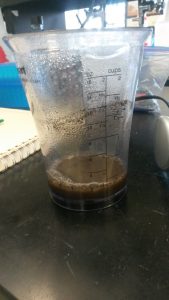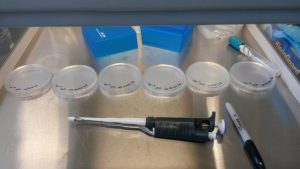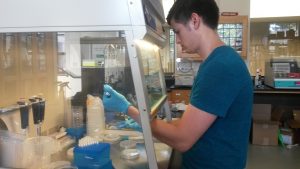June 10th, 2016
Today was extremely fun! I learned that there’s a lot more to the process of transferring bacteria onto agar plates than simply just slopping some soil into PBS and then scooping an arbitrary amount up to dump onto the agar gel. It’s quite possible for too much bacteria to grow on a single agar plate, creating what’s referred to as a “lawn”. When a lawn forms, it’s extremely difficult to count the colonies that form and many species of bacteria are outgrown by others that grow quicker. It is just not an ideal representation of the true microbial diversity within the sample. To prevent this from happening, the soil samples have to be diluted so the bacteria within them that will be plated (added to the agar plates) are much less concentrated, which will allow them plenty of room to grow and make them much easier to count.
Tess show me how to prepare different dilutions for the north-facing slope soil samples. It consisted of mixing the soil sample with PBS so that only 10% of the solution would contain soil making a dilution of 10-1 and blending it for 5 minutes. Then another solution was made in a small 2 mL plastic container that contained PBS and the 10-1 solution in which the concentration of the 10-1 solution made up only 10% of the new solution. This created a dilution of 10-2. This process was  continued another 3 times so that each 2 mL container consisted of only 10% of the previous solution, meaningwe created dilutions of 10-2, 10-3, 10-4, and 10-5. A small portion of the 10-3, 10-4, and 10-5 solutions were plated on agar plates with each dilution having a replicate pl
continued another 3 times so that each 2 mL container consisted of only 10% of the previous solution, meaningwe created dilutions of 10-2, 10-3, 10-4, and 10-5. A small portion of the 10-3, 10-4, and 10-5 solutions were plated on agar plates with each dilution having a replicate pl ate (2 plates per dilution) for a total of 6 agar plates. After showing me the process, Tess let me prepare all of the dilutions for the south-facing slope soil samples myself. I was nervous at first not having her to guide me in the process, but it ended up feeling much more natural to complete than I expected. The flow of each careful step helped me gain an appreciation for what was happening conceptually. The plates are going to be left over the weekend in an incubator to grow. I’m excited to see the results next Monday!
ate (2 plates per dilution) for a total of 6 agar plates. After showing me the process, Tess let me prepare all of the dilutions for the south-facing slope soil samples myself. I was nervous at first not having her to guide me in the process, but it ended up feeling much more natural to complete than I expected. The flow of each careful step helped me gain an appreciation for what was happening conceptually. The plates are going to be left over the weekend in an incubator to grow. I’m excited to see the results next Monday!
I brought up my ideas for the resuscitation substances with Tess and to my surprise, she was impressed with them! Last night I researched two concepts: Components in healthy soils and the physiological steps bacteria go through to change from an actively growing state to a dormant spore. After browsing useful websites and reading through a Microbiology textbook, I made a list of ideas that might be plausible conditions to test. After researching soil, I learned  about a few organic constituents that form from the decomposition of organic matter which greatly aid the growth of plants: humic acid and fulvic acid. I wondered to myself if these organic molecules would impact the growth of bacteria as well, although they have a large molecular size. After reading in my textbook about the steps that bacteria undergo to become an endospore (dormant state), I learned of two substances that are incorporated into the endospore wall to increase its resistance to changes in the conditions of the external environment: calcium ions and dipicolinic acid. I speculated what it might mean to reverse this process. Perhaps there is some sort of chemical we could subject a sample of bacteria to that would strongly bind to the Ca2+ ions helping to break up the wall? Ultimately, I wasn’t sure if this wou
about a few organic constituents that form from the decomposition of organic matter which greatly aid the growth of plants: humic acid and fulvic acid. I wondered to myself if these organic molecules would impact the growth of bacteria as well, although they have a large molecular size. After reading in my textbook about the steps that bacteria undergo to become an endospore (dormant state), I learned of two substances that are incorporated into the endospore wall to increase its resistance to changes in the conditions of the external environment: calcium ions and dipicolinic acid. I speculated what it might mean to reverse this process. Perhaps there is some sort of chemical we could subject a sample of bacteria to that would strongly bind to the Ca2+ ions helping to break up the wall? Ultimately, I wasn’t sure if this wou ld generate a resuscitation response or if it would just damage the cells and kill them, but it was certainly a unique idea. This latter idea didn’t end up being plausible after Tess researched further and discovered that the Ca2+ ions were incorporated into an inner spore wall (endospore) that wouldn’t come in contact with any chemical we’d expose the cells to; nonetheless, I felt proud of myself for thinking outside of the box and coming up with a wacky idea that possibly no one has thought of before to research.
ld generate a resuscitation response or if it would just damage the cells and kill them, but it was certainly a unique idea. This latter idea didn’t end up being plausible after Tess researched further and discovered that the Ca2+ ions were incorporated into an inner spore wall (endospore) that wouldn’t come in contact with any chemical we’d expose the cells to; nonetheless, I felt proud of myself for thinking outside of the box and coming up with a wacky idea that possibly no one has thought of before to research.
Noah visited Tess and me today because he had an idea for our experiment. He started drawing out his ideas on a piece of paper starting with the two preconditions all of the soil would be subject to before using DNA sequencing to identify the bacteria species in each sample (bacteria that will undergo an intense ethanol treatment an d bacteria that won’t). He spoke of a substance called propidium monoazide (PMA) which is a dye that binds strongly to DNA which Paul and Tess are familiar with using. The goal would be for the PMA to bind to free floating DNA in the samples which would allow for us to remove excess DNA that doesn’t actually belong to any of the living bacteria species in the soil. This was something I hadn’t considered at all, I didn’t realize that DNA might be present inside the soil from bacteria that had died and spilled its innards into the soil, which of course would be included in the sequencing sample. I was grateful that Noah approached us about this idea. It means yet another change in our project procedure, but it will certainly increase the accuracy of our data. I thought to myself, “So this is what research is like… You think you know exactly what you’re going to test, and then an idea changes everything.” Our initial experimental procedure looks much different than the one we have planned now.
d bacteria that won’t). He spoke of a substance called propidium monoazide (PMA) which is a dye that binds strongly to DNA which Paul and Tess are familiar with using. The goal would be for the PMA to bind to free floating DNA in the samples which would allow for us to remove excess DNA that doesn’t actually belong to any of the living bacteria species in the soil. This was something I hadn’t considered at all, I didn’t realize that DNA might be present inside the soil from bacteria that had died and spilled its innards into the soil, which of course would be included in the sequencing sample. I was grateful that Noah approached us about this idea. It means yet another change in our project procedure, but it will certainly increase the accuracy of our data. I thought to myself, “So this is what research is like… You think you know exactly what you’re going to test, and then an idea changes everything.” Our initial experimental procedure looks much different than the one we have planned now.
This week has been one of the most exciting weeks of my life! I’m started to get used to the flow of a typical day in the laboratory and I can’t say I’ve ever had more fun at work within the 6-7 years that I’ve been in the workforce. Working in the lab beats any second I’ve spent in the customer service world. This leads me to believe that this is exactly what I should be doing with my time. Each day that I show up for work, I feel excited for what’s to come next. I’ve never known such a blissful feeling – my interests and work melding together into an electrifying experience! I think I might know now what it feels like to transform an interest into a passion.
